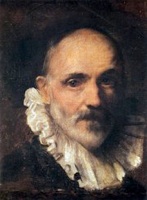
Self portrait (ca. 1570) by Federico Barocci
Uffizi Gallery, Florence
Federico Fiori Barocci was born in Urbino. He worked for Pope Pius IV in the Casino in the Vatican Gardens in 1561-3, but was then forced to return to Urbino because of a health problem that was to trouble him for the rest of his life. (It is said that he thought that his rivals were trying to poison him!). He enjoyed both the patronage and the friendship of Francesco Maria II della Rovere, who succeeded his father as Duke of Urbino in 1574.
Federico Barocci achieved a brilliant career, despite his absence from Rome. His art was responsive to the promptings of the Council of Trent, which required that religious paintings should be realistic and express emotion, in order to inform the viewer and also move him or her to devotion. The altarpieces that he painted for the Oratorian Fathers of Santa Maria in Valicella (Chiesa Nuova) in 1586-1603 were particularly important in establishing his reputation. He also collaborated with engravers such as Cornelis Cort in the 1570s and 1580s, and this led to the dissemination of many of his compositions in print. A series of other artist made use of these prints in their work.
Assisi
Annunciation (1591-6)
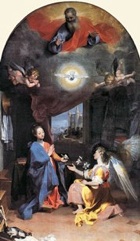
The altarpiece, which is now above the door in the right transept of Santa Maria degli Angeli, is based on the Annunciation (1582-4) that Barocci painted for the chapel of Francesco Maria II della Rovere in the Basilica della Santa Casa, Loreto, which is now in the Pinacoteca Vaticana. (This link to the Web Gallery of Art also has a copy of the image at Santa Maria degli Angeli, which it erroneously says is in Perugia). Both works are set in a darkened room, with a curtain raised at the window to reveal a view of the ducal palace of Urbino. A kitten sleeps on a chair at the bottom left.
Laura Pontani Coli was indeed fortunate to have secured this commission from such a busy and prestigious artist. It has been suggested that she was also able to help the Confraternita del SS Crocifisso of Perugia (to whom she subsequently left money in her will) to secure the services of Felice Pellegrini, one of Barocci’s closest followers, to paint the altarpiece for their altar in 1593.
Gubbio
Annunciation (1609-19)
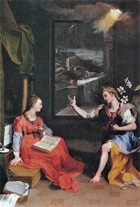
The panel seems originally to have been used in processions, but the confraternity decided in 1641 to end this practice, presumably because it was being damaged. It was finally installed on the new high altar of Santa Maria dei Laici in 1672.
The composition is obviously similar to other s based Barocci’s Annunciation (1582-4) in the Basilica della Santa Casa, Loreto (see Assisi above). However, the view of Urbino from the window in the prototype and others based on it has been replaced here by a view of Gubbio.
Perugia
Descent from the Cross (1569)
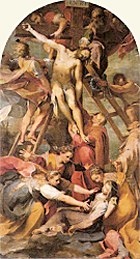
In the upper part of the altarpiece, Joseph of Arimathea and others struggle to remove the dead Christ from the Cross, while the Virgin swoons into the arms of her ladies below.
Madonna della Ciliegia (of the cherry) (1573)
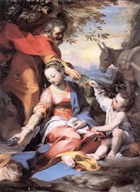
The panel actually depicts the Holy Family resting during their flight to Egypt: it takes its usual title from the fact that St Joseph is depicted picking cherries and giving them to the baby Jesus. It is one of a series that derive from a prototype (now lost) that Barocci painted for Duke Guidobaldo II della Rovere, Duke of Urbino: Duke Guidobaldo commissioned this prototype in 1570 as a present to Lucrezia d' Este on the occasion of her wedding to his son, the future Duke Francesco Maria II della Rovere.
Madonna and Child with saints (ca. 1580)
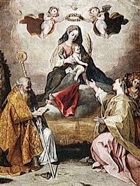
The altarpiece depicts the Madonna and Child enthroned with SS Antony Abbot and Lucy. The baby Jesus offers a palm of martyrdom to St Lucy while two flying angels hold a crown above the head of the Virgin.
Read more:
F. Mancini, “Un Documento per Federico Barocci e la Cappella Coli Pontani in Santa Maria degli Angeli” Esercizi, 6 (1983) pp 18-47
Return to Art in: Assisi Gubbio Perugia.
Return to “Foreign” Painters in Umbria.



